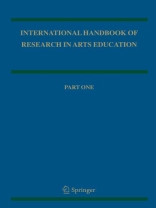Providing a distillation of knowledge in the various disciplines of arts education (dance, drama, music, literature and poetry and visual arts), the Handbook synthesizes existing research literature, helps define the past, and contributes to shaping the substantive and methodological future of the respective and integrated disciplines of arts education. While research can at times seem distant from practice, the Handbook aims to maintain connection with the lived practice of art and of education, capturing the vibrancy and best thinking in the field of theory and practice.
The Handbook is organized into 13 sections, each centering on a major area or issue in arts education research. These areas include: History of arts education, curriculum, evaluation, cultural centers, appreciation, composition, informal learning, child culture, creativity, the body, spirituality, and technology. The individual chapters address cross-cultural research related to the central theme of the section from the perspectives of the particular arts discipline. Interludes provide reflective thoughts on the theme.
表中的内容
From the contents Introduction: Liora Bresler.- Book One: Section 1: History Section Editor: Gordon Cox.- Section 2: Curriculum Section Editor: Curriculum.- Section 3: Evaluation Section Editor: Regina Murphy and Magne Espeland.- Section 4: Composition Section Editor: Sarah Mc Carthey.- Section 5: Appreciation Section Editor: Margaret Barrett.- Section 6: Museums and Cultural Centers Section Editor: Elizabeth Vallance.- Book Two: Section 7: Informal Leaning Section Editor: Minette Mans.- Section 8: Child Culture Section Editor: Christine Marme Thompson.- Section 9: Social and Cultural Issues Section Editor: Douglas Risner and Tracie Costantino.- Section 10: The Body Section Editor: Kimberley Powell.- Section 11: Creativity Section Editor Pamela Burnard.- Section 12: Technology Section Editor Peter R. Webster.- Section 13: Spirituality Section Editor: Rita L. Irwin.












